公司理财第六章投资决策思考题第一题
- 格式:docx
- 大小:16.74 KB
- 文档页数:2
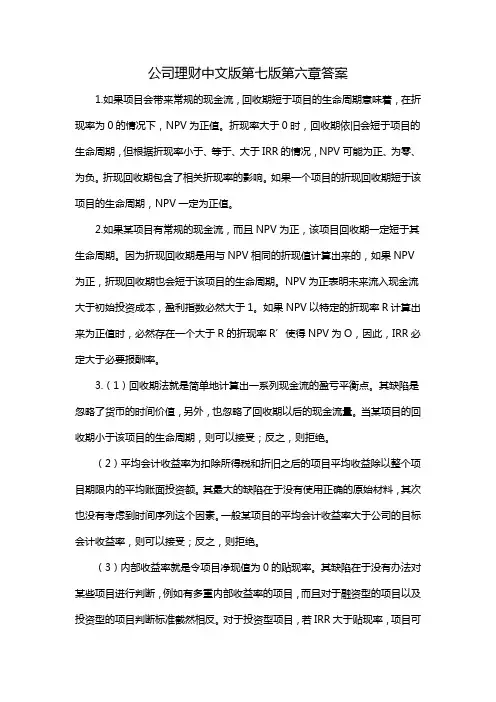
公司理财中文版第七版第六章答案1.如果项目会带来常规的现金流,回收期短于项目的生命周期意味着,在折现率为0的情况下,NPV为正值。
折现率大于0时,回收期依旧会短于项目的生命周期,但根据折现率小于、等于、大于IRR的情况,NPV可能为正、为零、为负。
折现回收期包含了相关折现率的影响。
如果一个项目的折现回收期短于该项目的生命周期,NPV一定为正值。
2.如果某项目有常规的现金流,而且NPV为正,该项目回收期一定短于其生命周期。
因为折现回收期是用与NPV相同的折现值计算出来的,如果NPV 为正,折现回收期也会短于该项目的生命周期。
NPV为正表明未来流入现金流大于初始投资成本,盈利指数必然大于1。
如果NPV以特定的折现率R计算出来为正值时,必然存在一个大于R的折现率R’使得NPV为O,因此,IRR必定大于必要报酬率。
3.(1)回收期法就是简单地计算出一系列现金流的盈亏平衡点。
其缺陷是忽略了货币的时间价值,另外,也忽略了回收期以后的现金流量。
当某项目的回收期小于该项目的生命周期,则可以接受;反之,则拒绝。
(2)平均会计收益率为扣除所得税和折旧之后的项目平均收益除以整个项目期限内的平均账面投资额。
其最大的缺陷在于没有使用正确的原始材料,其次也没有考虑到时间序列这个因素。
一般某项目的平均会计收益率大于公司的目标会计收益率,则可以接受;反之,则拒绝。
(3)内部收益率就是令项目净现值为0的贴现率。
其缺陷在于没有办法对某些项目进行判断,例如有多重内部收益率的项目,而且对于融资型的项目以及投资型的项目判断标准截然相反。
对于投资型项目,若IRR大于贴现率,项目可以接受;反之,则拒绝。
对于融资型项目,若IRR小于贴现率,项目可以接受;反之,则拒绝。
(4)盈利指数是初始以后所有预期未来现金流量的现值和初始投资的比值。
必须注意的是,倘若初始投资期之后,在资金使用上还有限制,那盈利指数就会失效。
对于独立项目,若PI大于1,项目可以接受;反之,则拒绝。
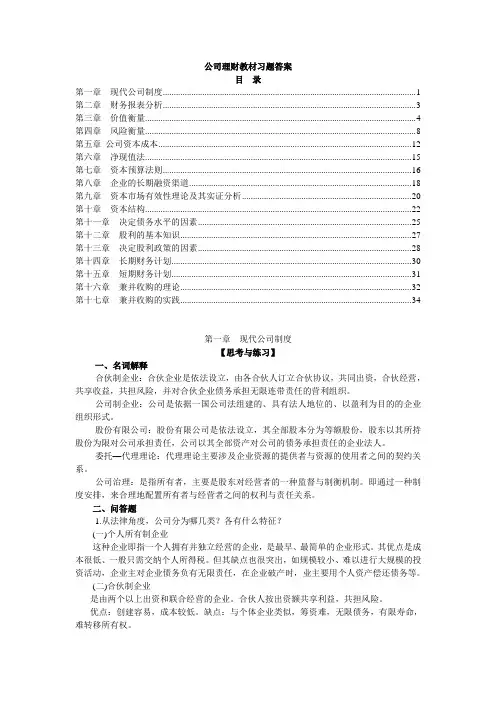
公司理财教材习题答案目录第一章现代公司制度 (1)第二章财务报表分析 (3)第三章价值衡量 (4)第四章风险衡量 (8)第五章公司资本成本 (12)第六章净现值法 (15)第七章资本预算法则 (16)第八章企业的长期融资渠道 (18)第九章资本市场有效性理论及其实证分析 (20)第十章资本结构 (22)第十一章决定债务水平的因素 (25)第十二章股利的基本知识 (27)第十三章决定股利政策的因素 (28)第十四章长期财务计划 (30)第十五章短期财务计划 (31)第十六章兼并收购的理论 (32)第十七章兼并收购的实践 (34)第一章现代公司制度【思考与练习】一、名词解释合伙制企业:合伙企业是依法设立,由各合伙人订立合伙协议,共同出资,合伙经营,共享收益,共担风险,并对合伙企业债务承担无限连带责任的营利组织。
公司制企业:公司是依据一国公司法组建的、具有法人地位的、以盈利为目的的企业组织形式。
股份有限公司:股份有限公司是依法设立,其全部股本分为等额股份,股东以其所持股份为限对公司承担责任,公司以其全部资产对公司的债务承担责任的企业法人。
委托—代理理论:代理理论主要涉及企业资源的提供者与资源的使用者之间的契约关系。
公司治理:是指所有者,主要是股东对经营者的一种监督与制衡机制。
即通过一种制度安排,来合理地配置所有者与经营者之间的权利与责任关系。
二、问答题1.从法律角度,公司分为哪几类?各有什么特征?(一)个人所有制企业这种企业即指一个人拥有并独立经营的企业,是最早、最简单的企业形式。
其优点是成本很低、一般只需交纳个人所得税。
但其缺点也很突出,如规模较小、难以进行大规模的投资活动,企业主对企业债务负有无限责任,在企业破产时,业主要用个人资产偿还债务等。
(二)合伙制企业是由两个以上出资和联合经营的企业。
合伙人按出资额共享利益,共担风险。
优点:创建容易,成本较低。
缺点:与个体企业类似,筹资难,无限债务,有限寿命,难转移所有权。
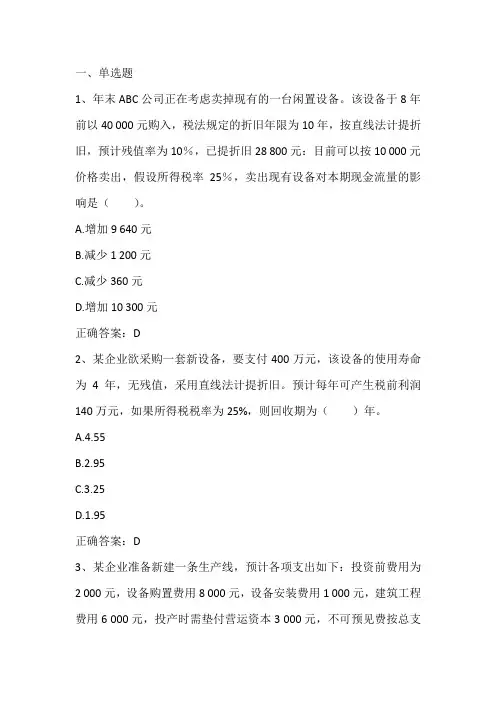
一、单选题1、年末ABC公司正在考虑卖掉现有的一台闲置设备。
该设备于8年前以40 000元购入,税法规定的折旧年限为10年,按直线法计提折旧,预计残值率为10%,已提折旧28 800元:目前可以按10 000元价格卖出,假设所得税率25%,卖出现有设备对本期现金流量的影响是()。
A.增加9 640元B.减少1 200元C.减少360元D.增加10 300元正确答案:D2、某企业欲采购一套新设备,要支付400万元,该设备的使用寿命为4年,无残值,采用直线法计提折旧。
预计每年可产生税前利润140万元,如果所得税税率为25%,则回收期为()年。
A.4.55B.2.95C.3.25D.1.95正确答案:D3、某企业准备新建一条生产线,预计各项支出如下:投资前费用为2 000元,设备购置费用8 000元,设备安装费用1 000元,建筑工程费用6 000元,投产时需垫付营运资本3 000元,不可预见费按总支出的5%计算,则该生产线的投资总额为()。
A.20 000B.17 850C.21 000D.17 000正确答案:C4、使投资净现值完全等于零的折现率称为()。
A.盈利指数B.平衡点C.内部收益率D.外部收益率正确答案:C5、一个项目的初始成本是2 100美元。
未来四年的现金流入分别为0美元、500美元、900美元和700美元。
投资回收期是()。
A.3 yearsB.1 yearsC.4 yearsD.2 years正确答案:C6、ABC公司正在讨论更新现有的一项固定资产,有两个备选方案:方案一的净现值为55万元,内含报酬率为9.6%;方案二的净现值为70万元,内含报酬率为8%,若两方案有效年限相同,据此可以认定()。
A.方案二较好B.两方案一样好C.方案一较好D.需要利用等额年金法才能做出判断正确答案:A二、多选题1、下列有关固定资产更新决策表述正确的有()。
A.固定资产更新决策方法比较适合采用内含报酬率法B.寿命期相同的设备重置决策可以采用净现值法进行决策C.寿命期不同的设备重置决策可以采用年金净流量法进行决策D.从决策性质看固定资产更新决策属于独立方案的决策类型正确答案:B、C2、在投资决策分析中使用的折现现金流量指标有()。
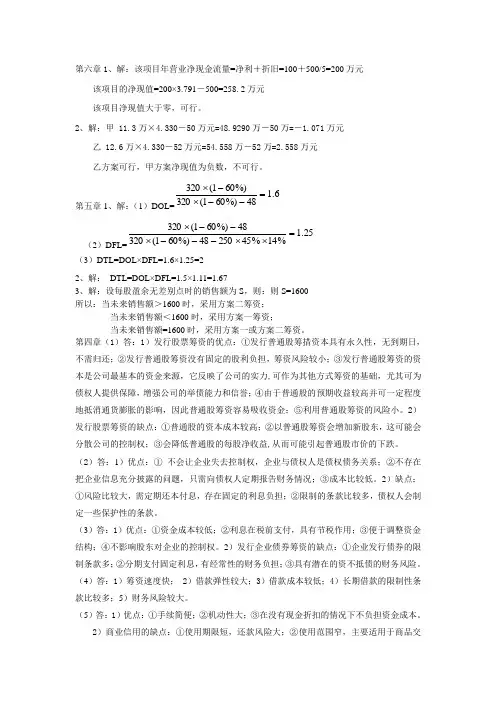
第六章1、解:该项目年营业净现金流量=净利+折旧=100+500/5=200万元该项目的净现值=200×3.791-500=258. 2万元该项目净现值大于零,可行。
2、解:甲 11.3万×4.330-50万元=48.9290万-50万=-1.071万元乙 12.6万×4.330-52万元=54.558万-52万=2.558万元乙方案可行,甲方案净现值为负数,不可行。
第五章1、解:(1)DOL=6.148%)601(320%)601(320=--⨯-⨯(2)DFL=25.1%14%4525048%)601(32048%)601(320=⨯⨯---⨯--⨯(3)DTL=DOL×DFL=1.6×1.25=22、解:DTL=DOL×DFL=1.5×1.11=1.673、解:设每股盈余无差别点时的销售额为S,则:则S=1600所以:当未来销售额>1600时,采用方案二筹资;当未来销售额<1600时,采用方案一筹资;当未来销售额=1600时,采用方案一或方案二筹资。
第四章(1)答:1)发行股票筹资的优点:①发行普通股筹措资本具有永久性,无到期日,不需归还;②发行普通股筹资没有固定的股利负担,筹资风险较小;③发行普通股筹资的资本是公司最基本的资金来源,它反映了公司的实力,可作为其他方式筹资的基础,尤其可为债权人提供保障,增强公司的举债能力和信誉;④由于普通股的预期收益较高并可一定程度地抵消通货膨胀的影响,因此普通股筹资容易吸收资金;⑤利用普通股筹资的风险小。
2)发行股票筹资的缺点:①普通股的资本成本较高;②以普通股筹资会增加新股东,这可能会分散公司的控制权;③会降低普通股的每股净收益,从而可能引起普通股市价的下跌。
(2)答:1)优点:①不会让企业失去控制权,企业与债权人是债权债务关系;②不存在把企业信息充分披露的问题,只需向债权人定期报告财务情况;③成本比较低。
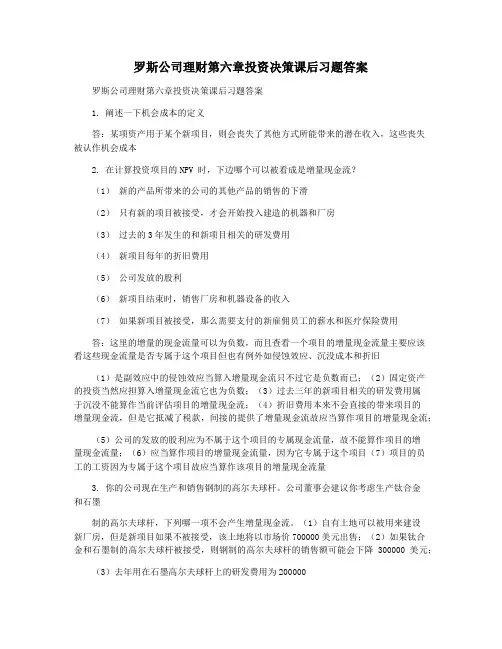
罗斯公司理财第六章投资决策课后习题答案罗斯公司理财第六章投资决策课后习题答案1. 阐述一下机会成本的定义答:某项资产用于某个新项目,则会丧失了其他方式所能带来的潜在收入,这些丧失被认作机会成本2. 在计算投资项目的NPV 时,下边哪个可以被看成是增量现金流?(1)新的产品所带来的公司的其他产品的销售的下滑(2)只有新的项目被接受,才会开始投入建造的机器和厂房(3)过去的3年发生的和新项目相关的研发费用(4)新项目每年的折旧费用(5)公司发放的股利(6)新项目结束时,销售厂房和机器设备的收入(7)如果新项目被接受,那么需要支付的新雇佣员工的薪水和医疗保险费用答:这里的增量的现金流量可以为负数,而且查看一个项目的增量现金流量主要应该看这些现金流量是否专属于这个项目但也有例外如侵蚀效应、沉没成本和折旧(1)是副效应中的侵蚀效应当算入增量现金流只不过它是负数而已;(2)固定资产的投资当然应担算入增量现金流它也为负数;(3)过去三年的新项目相关的研发费用属于沉没不能算作当前评估项目的增量现金流;(4)折旧费用本来不会直接的带来项目的增量现金流,但是它抵减了税款,间接的提供了增量现金流故应当算作项目的增量现金流;(5)公司的发放的股利应为不属于这个项目的专属现金流量,故不能算作项目的增量现金流量;(6)应当算作项目的增量现金流量,因为它专属于这个项目(7)项目的员工的工资因为专属于这个项目故应当算作该项目的增量现金流量3. 你的公司现在生产和销售钢制的高尔夫球杆。
公司董事会建议你考虑生产钛合金和石墨制的高尔夫球杆,下列哪一项不会产生增量现金流。
(1)自有土地可以被用来建设新厂房,但是新项目如果不被接受,该土地将以市场价700000美元出售;(2)如果钛合金和石墨制的高尔夫球杆被接受,则钢制的高尔夫球杆的销售额可能会下降300000美元;(3)去年用在石墨高尔夫球杆上的研发费用为200000答:对于(1)属于机会成本应当算入项目的增量现金流(2)属于副效应中的侵蚀效应应当算入项目的增量现金流;(3)属于沉没成本,不应当算入项目的增量现金流4. 如果可以选择,你更愿意接受直线折旧法还是改进的加速成本折旧法?为什么答:应该更加偏向于加速成本折旧法,因为它在前期产生了更多的折旧额,抵减了更多的税款(从货币的时间价值上来说)5. 我们在前面套路资本预算的时候,我们假设投资项目的营运资本都能够回收。
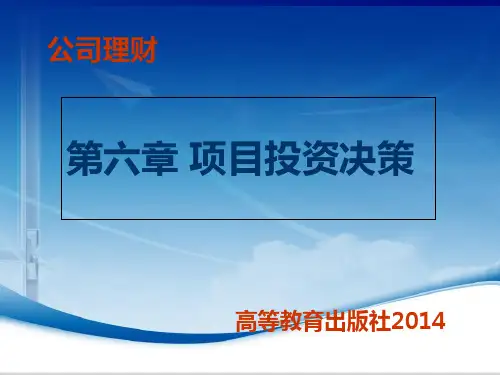
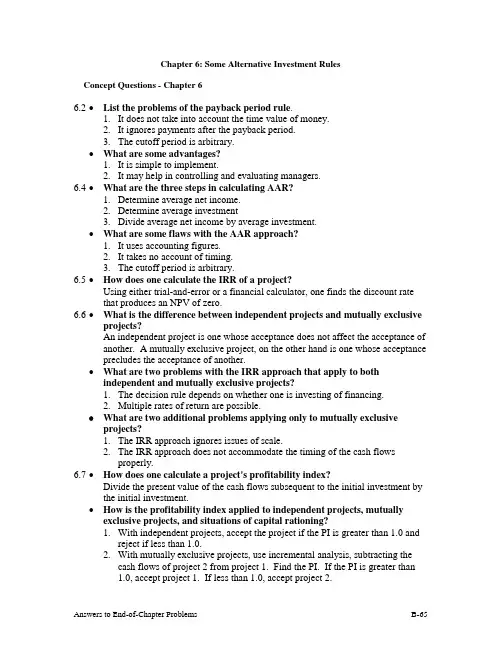
Chapter 6: Some Alternative Investment RulesConcept Questions - Chapter 66.2 ∙List the problems of the payback period rule.1.It does not take into account the time value of money.2.It ignores payments after the payback period.3.The cutoff period is arbitrary.∙What are some advantages?1.It is simple to implement.2.It may help in controlling and evaluating managers.6.4 ∙What are the three steps in calculating AAR?1.Determine average net income.2.Determine average investment3.Divide average net income by average investment.∙What are some flaws with the AAR approach?1.It uses accounting figures.2.It takes no account of timing.3.The cutoff period is arbitrary.6.5 ∙How does one calculate the IRR of a project?Using either trial-and-error or a financial calculator, one finds the discount ratethat produces an NPV of zero.6.6 ∙What is the difference between independent projects and mutually exclusiveprojects?An independent project is one whose acceptance does not affect the acceptance of another. A mutually exclusive project, on the other hand is one whose acceptance precludes the acceptance of another.∙What are two problems with the IRR approach that apply to both independent and mutually exclusive projects?1.The decision rule depends on whether one is investing of financing.2.Multiple rates of return are possible.∙What are two additional problems applying only to mutually exclusive projects?1.The IRR approach ignores issues of scale.2.The IRR approach does not accommodate the timing of the cash flowsproperly.6.7 ∙How does one calculate a project's profitability index?Divide the present value of the cash flows subsequent to the initial investment by the initial investment.∙How is the profitability index applied to independent projects, mutually exclusive projects, and situations of capital rationing?1.With independent projects, accept the project if the PI is greater than 1.0 andreject if less than 1.0.2.With mutually exclusive projects, use incremental analysis, subtracting thecash flows of project 2 from project 1. Find the PI. If the PI is greater than1.0, accept project 1. If less than 1.0, accept project2.3.In capital rationing, the firm should simply rank the projects according to theirrespective PIs and accept the projects with the highest PIs, subject to thebudget constrain.Answers to End-of-Chapter ProblemsQUESTIONS AND PROBLEMSThe Payback Period Rule6.1 Fuji Software, Inc., has the following projects.Year Project A Project B0 _$7,500 _$5,0001 4,000 2,5002 3,500 1,2003 1,500 3,000a. Suppose Fuji’s cutoff payback period is two years. Which of these two projects should be chosen?b. Suppose Fuji uses the NPV rule to rank these two projects. If the appropriate discount rate is 15 percent, which project should be chosen?6.1 a. Payback period of Project A = 1 + ($7,500 - $4,000) / $3,500 = 2 yearsPayback period of Project B = 2 + ($5,000 - $2,500 -$1,200) / $3,000 = 2.43 yearsProject A should be chosen.b. NPV A = -$7,500 + $4,000 / 1.15 + $3,500 / 1.152 + $1,500 / 1.153 = -$388.96NPV B = -$5,000 + $2,500 / 1.15 + $1,200 / 1.152 + $3,000 / 1.153 = $53.83Project B should be chosen.6.2 Suppose Peach Paving Company invests $1 million today on a new construction project. The project will generate annual cash flows of $150,000 in perpetuity. The appropriate annual discount rate for the project is 10 percent.a. What is the payback period for the project? If the Peach Paving Company desires to have a 10-year payback period, should the project be adopted?b. What is the discounted payback period for the project?c. What is the NPV of the project?6.2 a. Payback period = 6 + {$1,000,000 - ($150,000 ⨯ 6)} / $150,000 = 6.67 yearsYes, the project should be adopted.A= $974,259b. $150,000 11.010The discounted payback period = 11 + ($1,000,000 - $974,259) / ($150,000 / 1.112)= 11.54 yearsc. NPV = -$1,000,000 + $150,000 / 0.10 = $500,000The Average Accounting Return6.3 The annual, end-of-year, book-investment accounts for the machine whose purchase your firm is considering are shown below.Purchase Year Year Year YearDate 1 2 3 4Gross investment $16,000 $16,000 $16,000 $16,000 $16,000Less: accumulateddepreciation ______0_ ___4_,0_0_0_ ___8_,0_0_0_ __1_2_,0_0_0_ _1_6_,_0_0_0Net investment $16,000 $12,000 $ 8,000 $ 4,000 $ 0If your firm purchases this machine, you can expect it to generate, on average, $4,500 peryear in additional net income.a. What is the average accounting return for this machine?b. What three flaws are inherent in this decision rule?6.3 a. Average Investment:($16,000 + $12,000 + $8,000 + $4,000 + 0) / 5 = $8,000Average accounting return:$4,500 / $8,000 = 0.5625 = 56.25%b. 1. AAR does not consider the timing of the cash flows, hence it does notconsider the time value of money.2. AAR uses an arbitrary firm standard as the decision rule.3. AAR uses accounting data rather than net cash flows.6.4 Western Printing Co. has an opportunity to purchase a $2 million new printing machine. It has an economic life of five years and will be worthless after that time. This new investment is expected to generate an annual net income of $100,000 one year from today and the income stream will grow at 7 percent per year subsequently. The company adopts a straight-line depreciation method (i.e., equal amounts of depreciation in each year). What is the average accounting return of the investment? Supposing Western Printing’s AAR cutoff is 20 percent, should the machine be purchased?6.4 Average Investment = ($2,000,000 + 0) / 2 = $1,000,000Average net income = [$100,000 {(1 + g)5 - 1} / g] / 5= {$100,000A (1.075 - 1} / 0.07} / 5= $115,014.78AAR = $115,014.78 / $1,000,000 = 11.50%No, since the machine’s AAR is less than the firm’s cutoff AAR.6.5 Nokia Group has invested $8,000 in a high-tech project. This cost is depreciated on an accelerated basis that yields $4,000, $2,500, $1,500 of depreciation, respectively, during its three-year economic life. The project is expected to produce income before tax of $2,000 each year during its economic life. If the tax rate is 25%, what is the project’s average accounting return (AAR)?a. 44.44%b. 50.23%c. 66.67%d. 70.00%e. 82.21%The Internal Rate of Return6.5 a6.6 Compute the internal rate of return on projects with the following cash flows.Cash Flows ($)Year Project A Project B0 _3,000 _6,0001 2,500 5,0002 1,000 2,000/ $160,000 = 1.046.6PI = $40,000 715.0Since the PI exceeds one accept the project.6.7 CPC, Inc., has a project with the following cash flows.Year Cash Flows ($)0 _8,0001 4,0002 3,0003 2,000a. Compute the internal rate of return on the project.b. Suppose the appropriate discount rate is 8 percent. Should the project be adopted by CPC?6.7 The IRR is the discount rate at which the NPV = 0.-$3,000 + $2,500 / (1 + IRR A) + $1,000 / (1 + IRR A)2 = 0By trial and error, IRR A = 12.87%Since project B’s cash flows are two times of those of project A, the IRR B = IRR A =12.87%6.8 Compute the internal rate of return for the cash flows of the following two projects.Cash Flows ($)Time A B0 _2,000 _1,5001 2,000 5002 8,000 1,0003 _8,000 1,5006.8 a. Solve x by trial and error:-$4,000 + $2,000 / (1 + x) + $1,500 / (1 + x)2 + $1,000 / (1 + x)3 = 0x = 6.93%b. No, since the IRR (6.93%) is less than the discount rate of 8%.6.9 Suppose you are offered $5,000 today and obligated to make scheduled payments as follows:Year Cash Flows ($)0 5,0001 _2,5002 _2,0003 _1,0004 _1,000a. What is the IRRs of this offer?b. If the appropriate discount rate is 10 percent, should you accept this offer?c. If the appropriate discount rate is 20 percent, should you accept this offer?Chapter 6 Some Alternative Investment Rules 165d. What is the corresponding NPV of the project if the appropriate discount rates are 10 percent and 20 percent, respectively? Are the choices under the NPV rule consistent with those of the IRR rule?6.9 Find the IRRs of project A analytically. Since the IRR is the discount rate that makes the NPVequal to zero, the following equation must hold.-$200 + $200 / (1 + r) + $800 / (1 + r)2 - $800 / (1 + r)3 = 0$200 [-1 + 1 / (1 + r)] - {$800 / (1 + r)2}[-1 + 1 / (1 + r)] = 0[-1 + 1 / (1 + r)] [$200 - $800 / (1 + r)2] = 0For this equation to hold, either [-1 + 1 / (1 + r)] = 0 or [$200 - $800 / (1 + r)2] = 0.Solve each of these factors for the r that would cause the factor to equal zero. Theresulting rates are the two IRRs for project A. They are either r = 0% or r = 100%.Note: By inspection you should have known that one of the IRRs of project A iszero. Notice that the sum of the un-discounted cash flows for project A is zero.Thus, not discounting the cash flows would yield a zero NPV. The discount ratewhich is tantamount to not discounting is zero.Here are some of the interactions used to find the IRR by trial and error.Sophisticated calculators can compute this rate without all of the tedium involved inthe trial-and-error method.NPV = -$150 + $50 / 1.3 + $100 / 1.32 + $150 / 1.33 = $15.91NPV = -$150 + $50 / 1.4 + $100 / 1.42 + $150 / 1.43 = -$8.60NPV = -$150 + $50 / 1.37 + $100 / 1.372 + $150 / 1.373 = -$1.89NPV = -$150 + $50 / 1.36 + $100 / 1.36 2 + $150 / 1.363 = $0.46NPV = -$150 + $50 / 1.36194 + $100 / 1.361942 + $150 / 1.361943= $0.0010NPV = -$150 + $50 / 1.36195 + $100 / 1.361952 + $150 / 1.361953= -$0.0013NPV = -$150 + $50 / 1.361944 + $100 / 1.3619442 + $150 / 1.3619443= $0.0000906Thus, the IRR is approximately 36.1944%.6.10 As the Chief Financial Officer of the Orient Express, you are offered the following twomutually exclusive projects.Year Project A Project B0 _$5,000 _$100,0001 3,500 65,0002 3,500 65,000a. What are the IRRs of these two projects?b. If you are told only the IRRs of the projects, which would you choose?c. What did you ignore when you made your choice in part (b)?d. How can the problem be remedied?e. Compute the incremental IRR for the projects.f. Based on your answer to part (e), which project should you choose?g. Suppose you have determined that the appropriate discount rate for these projectsis 15 percent. According to the NPV rule, which of these two projects should beadopted?6.10 a. Solve r in the equation:$5,000 - $2,500 / (1 + r) - $2,000 / (1 + r)2 - $1,000 / (1 + r)3- $1,000 / (1 + r)4 = 0By trial and error,IRR = r = 13.99%b. Since this problem is the case of financing, accept the project if the IRR is less thanthe required rate of return.IRR = 13.99% > 10%Reject the offer.c. IRR = 13.99% < 20%Accept the offer.d. When r = 10%:NPV = $5,000 - $2,500 / 1.1 - $2,000 / 1.12 - $1,000 / 1.13 - $1,000 / 1.14= -$359.95When r = 20%:NPV = $5,000 - $2,500 / 1.2 - $2,000 / 1.22 - $1,000 / 1.23 - $1,000 / 1.24= $466.82Yes, they are consistent with the choices of the IRR rule since the signs of the cashflows change only once.6.11 Consider two streams of cash flows, A and B. Cash flow A consists of $5,000 starting three years from today and growing at 4 percent in perpetuity. Cash flow B consists of _$6,000 starting two years from today and continuing in perpetuity. Assume the appropriate discount rate is 12 percent.a. What is the present value of each stream?b. What is the IRR of a project C, which is a combination of projects A and B; that is, C _ A _ B?c. If it is assumed that the discount rate is always positive, what is the rule related to IRR for assessing project C that would correspond to the NPV rule?6.11 a. Project A:NPV = -$5,000 + $3,500 / (1 + r) + $3,500 / (1 + r)2 = 0IRR = r = 25.69%Project B:NPV = -$100,000 + $65,000 / (1 + r) + $65,000 / (1 + r)2 = 0IRR = r = 19.43%b. Choose project A because it has a higher IRR.c. The difference in scale is ignored.d. Apply the incremental IRR method.e.C0C1C2B - A -$95,000 $61,500 $61,500NPV = -$95,000 + $61,500 / (1 + r) + $61,500 / (1 + r)2 = 0Incremental IRR = r = 19.09%f. If the discount rate is less than 19.09%, choose project B.Otherwise, choose project A.g. NPV A = -$5,000 + $3,500 / 1.15 + $3,500 / 1.152 = $689.98NPV B = -$100,000 + $65,000 / 1.15 + $65,000 / 1.152 = $5,671.08Choose project B.6.12 Project A involves an investment of $1 million, and project B involves an investment of $2 million. Both projects have a unique internal rate of return of 20 percent. Is the following statement true or false? Explain your answer.For any discount rate between 0 percent and 20 percent, inclusive, project B has an NPV twice as great as that of project A.6.12 a. PV A = {$5,000 / (0.12 - 0.04)} / 1.122 = $49,824.61 PV B = (-$6,000 / 0.12) / 1.12 = -$44,642.86 b. The IRR for project C must solve{$5,000 / (x - 0.04)} / (1 + x)2 + (-$6,000 / x) / (1 + x) = 0 $5,000 / (x - 0.04) - $6,000 (1 + x) / x = 0 25 x 2 + 3.17 x - 1 =0x = {-3.17 - (110.0489)0.5} / 50 or {-3.17 + (110.0489)0.5} / 50 The relevant positive root is IRR = x = 0.1464 = 14.64%c.To arrive at the appropriate decision rule, we must graph the NPV as a function of the discount rate. At a discount rate of 14.64% the NPV is zero. To determine if the graph is upward or downward sloping, check the NPV at another discount rate. At a discount rate of 10% the NPV is $14,325.07 [= $68,870.52 - $54,545.54]. Thus, the graph of the NPV is downward sloping. From the discussion in the text, if an NPV graph is downward sloping, the project is an investing project. The correct decision rule for an investing project is to accept the project if the discount rate is below 14.64%.The Profitability Index6.13 Suppose the following two mutually exclusive investment opportunities are available to the DeAngelo Firm. The appropriate discount rate is 10 percent. Year Project Alpha Project Beta 0 _$500 _$2,000 1 _300 _300 2 700 1,800 3 600 1,700a. What is the NPV of project alpha and project beta?b. Which project would you recommend for the DeAngelo Firm?6.13 Generally, the statement is false. If the cash flows of project B occur early and the cashflows of project A occur late, then for a low discount rate the NPV of A can exceed the NPV of B. Examples are easy to construct.14.64%10%rNPV$14,325.07C0C1C2IRR NPV @ 0% A: -$1,000,000 $0 $1,440,000 0.20 $440,000B: -2,000,000 2,400,000 0 0.20 400,000 In one particular case, the statement is true for equally risky projects. If the lives of thetwo projects are equal and in every time period the cash flows of the project B are twicethe cash flows of project A, then the NPV of project B will be twice as great as the NPV of project A for any discount rate between 0% and 20%.6.14 The firm for which you work must choose between the following two mutually exclusive projects. The appropriate discount rate for the projects is 10 percent.ProfitabilityC0 C1 C2 Index NPVA _$1,000 $1,000 $500 1.32 $322B _500 500 400 1.57 285The firm chose to undertake A. At a luncheon for shareholders, the manager of a pension fund that owns a substantial amount of the firm’s stock asks you why the firm chose project A instead of project B when B is more profitable.How would you justify your firm’s action? Are there any circumstances under which the pension fund manager’s argument could be correct?6.14 a. NPVα = $756.57 - $500 = $256.57NPVβ = $2,492.11 - $2,000 = $492.11b. Choose project beta.6.15 The treasurer of Davids, Inc., has projected the cash flows of projects A, B, and C as follows. Suppose the relevant discount rate is 12 percent a year.Year Project A Project B Project C0 _$100,000 _$200,000 _$100,0001 70,000 130,000 75,0002 70,000 130,000 60,000a. Compute the profitability indices for each of the three projects.b. Compute the NPVs for each of the three projects.c. Suppose these three projects are independent. Which projects should Davids accept based on the profitability index rule?d. Suppose these three projects are mutually exclusive. Which project should Davids accept based on the profitability index rule?e. Suppose Davids’ budget for these projects is $300,000. The projects are not divisible. Which projects should Davids accept?6.15 Although the profitability index is higher for project B than for project A, the NPV is theincrease in the value of the company that will occur if a particular project is undertaken.Thus, the project with the higher NPV should be chosen because it increases the value of the firm the most. Only in the case of capital rationing could the pension fund manager be correct.6.16 Bill plans to open a self-serve grooming center in a storefront. The grooming equipment will cost $160,000. Bill expects the after-tax cash inflows to be $40,000 annually for seven years, after which he plans to scrap the equipment and retire to the beaches of Jamaica.Assume the required return is 15%. What is the project’s PI? Should it be accepted?Comparison of Investment Rules6.16 a. PI A = ($70,000 / 1.12 + $70,000 / 1.122) / $100,000 = 1.183PI B = ($130,000 / 1.12 + $130,000 / 1.122) / $200,000 = 1.099PI C = ($75,000 / 1.12 + $60,000 / 1.122) / $100,000 = 1.148b. NPV A = -$100,000 + $118,303.57 = $18,303.57NPV B = -$200,000 + $219,706.63 = $19,706.63NPV C = -$100,000 + $114,795.92 = $14,795.92c. Accept all three projects because PIs of all the three projects are greater than one.d. Based on the PI rule, project C can be eliminated because its PI is less than the oneof project A, while both have the same amount of the investment. We can computethe PI of the incremental cash flows between the two projects,Project C0C1C2PIB - A -$100,000 $60,000 $60,000 1.014We should take project B since the PI of the incremental cash flows is greater thanone.e. Project B has the highest NPV, while A has the next highest NPV.Take both projects A and B.6.17 Define each of the following investment rules. In your definition state the criteria for accepting or rejecting an investment under each rule.a. Payback periodb. Average accounting returnc. Internal rate of returnd. Profitability indexe. Net present value6.17 a. The payback period is the time it takes to recoup the initial investment of a project.Accept any project that has a payback period that is equal to or shorter than thecompany’s standard payback period. Reject all other projects.b. The average accounting return (AAR) is defined asAverage project earnings ÷ Average book value of the investment.Accept pr ojects for which the AAR is equal to or greater than the firm’s standard.Reject all other projects.c. The internal rate of return (IRR) is the discount rate which makes the net presentvalue (NPV) of the project zero. The accept / reject criteria is:If C0 < 0 and all future cash flows are positive, accept the project if IRR ≥discount rate.If C0 < 0 and all future cash flows are positive, reject the project if IRR <discount rate.If C0 > 0 and all future cash flows are negative, accept the project if IRR ≤discount rate.If C0 > 0 and all future cash flows are negative, reject the project if IRR >discount rate.If the project has cash flows that alternate in sign, there is likely to be more thanone positive IRR. In that situation, there is no valid IRR accept / reject rule.d. The profitability index (PI) is defined as:(The present value of the cash flows subsequent to the initial investment ÷The initial investment)Accept any project for which the profitability index is equal to or greater thanone. Reject project for which that is not true.e. The net present value (NPV) is the sum of the present values of all project cashflows. Accept those projects with NPVs which are equal to or greater than zero.Rejects p roposals with negative NPVs.6.18 Consider the following cash flows of two mutually exclusive projects for Chinese Daily News.New Sunday New SaturdayYear Early Edition Late Edition0 _$1,200 _$2,1001 600 1,0002 550 9003 450 800a. Based on the payback period rule, which project should be chosen?b. Suppose there is no corporate tax and the cash flows above are income before the depreciation. The firm uses a straight-line depreciation method (i.e., equal amounts of depreciation in each year). What is the average accounting return for each of these two projects?c. Which project has a greater IRR?d. Based on the incremental IRR rule, which project should be chosen?6.18 Let project A represent New Sunday Early Edition; and let project B represent NewSaturday Late Edition.a. Payback period of project A = 2 + ($1,200 - $1,150) / $450 = 2.11 yearsPayback period of project B = 2 + ($2,100 - $1,900) / $800 = 2.25 yearsBased on the payback period rule, you should choose project A.b. Project A:Average investment = ($1,200 + $0) / 2 = $600Depreciation = $400 / yearAverage income = [($600 - $400) + ($550 - $400) + ($450 - $400)] / 3= $133.33AAR = $133.33 / $600 = 22.22%Project B:Average investment = ($2,100 + $0) / 2 = $1,050Depreciation = $700 / yearAverage income = [($1,000 - $700) + ($900 - $700) + ($800 - $700)] / 3= $200AAR = $200 / $1,050 = 19.05%c. IRR of project A:-$1,200 + $600 / (1 + r) + $550 / (1 + r)2 + $450 / (1 + r)3 = 0IRR = r = 16.76%IRR of project B:-$2,100 + $1,000 / (1 + r) + $900 / (1 + r)2 + $800 / (1 + r)3 = 0IRR = r = 14.29%Project A has a greater IRR.d. IRR of project B-A:Incremental cash flowsYear 0 1 2 3B - A -$900 $400 $350 $350-$900 + $400 / (1 + r) + $350 / (1 + r)2 + $350 / (1 + r)3 = 0Incremental IRR = r = 11.02%If the required rate of return is greater than 11.02%, then choose project A.If the required rate of return is less than 11.02%, then choose project B.6.19 Consider the following cash flows on two mutually exclusive projects that require an annual return of 15 percent. Working in the financial planning department for the Bahamas Recreation Corp., you are trying to compare different investment criteria to arrive at a sensible choice of these two projects.Deepwater New SubmarineYear Fishing Ride0 _$600,000 _$1,800,0001 270,000 1,000,0002 350,000 700,0003 300,000 900,000a. Based on the discounted payback period rule, which project should be chosen?b. If your decision rule is to accept the project with a greater IRR, which project should you choose?c. Since you are fully aware of the IRR rule’s scale problem, you calculate the incremental IRR for the cash flows. Based on your computation, which project should you choose?d. To be prudent, you compute the NPV for both projects. Which project should you choose? Is it consistent with the incremental IRR rule?6.19 Let project A be Deepwater Fishing; let project B be New Submarine Ride.a. Project A:Year Discounted CF Cumulative CF0 -$600,000 -$600,0001 234,783 -365,2172 264,650 -100,5673 197,255Discounted payback period of project A = 2 + $100,567 / $197,255= 2.51 yearsProject B:Year Discounted CF Cumulative CF0 -$1,800,000 -$1,800,0001 869,565 -930,4352 529,301 -401,1343 591,765Discounted payback period of project B = 2 + $401,134 / $591,765= 2.68 yearsProject A should be chosen.b. IRR of project A:-$600,000 + $270,000 / (1 + r) + $350,000 / (1 + r)2 + $300,000 / (1 + r)3 = 0IRR = r = 24.30%IRR of project B:-$1,800,000 + $1,000,000 /(1 + r) + $700,000 / (1 + r)2 + $900,000 / (1 + r)3= 0IRR = r = 21.46%Based on the IRR rule, project A should be chosen since it has a greater IRR.c. Incremental IRR:Year 0 1 2 3B - A -$1,200,000 $730,000 $350,000 $600,000-$1,200,000 + $730,000 / (1 + r) + $350,000 / (1 + r)2 + $600,000 / (1 + r)3 = 0Incremental IRR = r = 19.92%Since the incremental IRR is greater than the required rate of return, 15%, chooseproject B.d. NPV A = -$600,000 + $270,000 / 1.15 + $350,000 / 1.152 + $300,000 / 1.153= $96,687.76NPV B = -$1,800,000 + $1,000,000 / 1.15 + $700,000 / 1.152 + $900,000 / 1.153 = $190,630.39Since NPV B > NPV A, choose project B.Yes, the NPV rule is consistent with the incremental IRR rule.6.20 The Utah Mining Corporation is set to open a gold mine near Provo, Utah. According to the treasurer, Steven Sample, “This is a golden opportunity.” The mine will cost $600,000 to open. It will generate a cash inflow of $100,000 during the first year and the cash flows are projected to grow at 8 percent per year for 10 years. After 10 years the mine will be abandoned. Abandonment costs will be $50,000.a. What is the IRR for the gold mine?b. The Utah Mining Corporation requires a 10 percent return on such undertakings.Should the mine be opened?6.20 a. The IRR is the discount rate at which the NPV = 0Answers to End-of-Chapter Problems B-75-$600,000 + ()0r 1000,50$r 1%811%)8r (000,100$1111=+-⎥⎥⎦⎤⎢⎢⎣⎡⎪⎭⎫ ⎝⎛++--IRR ≈18.56% b. Yes, the mine should be opened since its IRR exceeds its required return of 10%.。
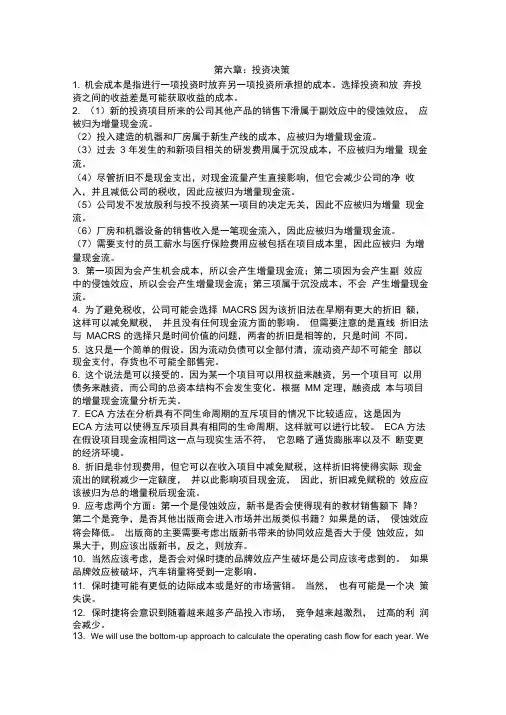
第六章:投资决策1. 机会成本是指进行一项投资时放弃另一项投资所承担的成本。
选择投资和放弃投资之间的收益差是可能获取收益的成本。
2. (1)新的投资项目所来的公司其他产品的销售下滑属于副效应中的侵蚀效应,应被归为增量现金流。
(2)投入建造的机器和厂房属于新生产线的成本,应被归为增量现金流。
(3)过去 3 年发生的和新项目相关的研发费用属于沉没成本,不应被归为增量现金流。
(4)尽管折旧不是现金支出,对现金流量产生直接影响,但它会减少公司的净收入,并且减低公司的税收,因此应被归为增量现金流。
(5)公司发不发放股利与投不投资某一项目的决定无关,因此不应被归为增量现金流。
(6)厂房和机器设备的销售收入是一笔现金流入,因此应被归为增量现金流。
(7)需要支付的员工薪水与医疗保险费用应被包括在项目成本里,因此应被归为增量现金流。
3. 第一项因为会产生机会成本,所以会产生增量现金流;第二项因为会产生副效应中的侵蚀效应,所以会会产生增量现金流;第三项属于沉没成本,不会产生增量现金流。
4. 为了避免税收,公司可能会选择MACRS因为该折旧法在早期有更大的折旧额,这样可以减免赋税,并且没有任何现金流方面的影响。
但需要注意的是直线折旧法与MACRS 的选择只是时间价值的问题,两者的折旧是相等的,只是时间不同。
5. 这只是一个简单的假设。
因为流动负债可以全部付清,流动资产却不可能全部以现金支付,存货也不可能全部售完。
6. 这个说法是可以接受的。
因为某一个项目可以用权益来融资,另一个项目可以用债务来融资,而公司的总资本结构不会发生变化。
根据MM 定理,融资成本与项目的增量现金流量分析无关。
7. ECA 方法在分析具有不同生命周期的互斥项目的情况下比较适应,这是因为ECA 方法可以使得互斥项目具有相同的生命周期,这样就可以进行比较。
ECA 方法在假设项目现金流相同这一点与现实生活不符,它忽略了通货膨胀率以及不断变更的经济环境。
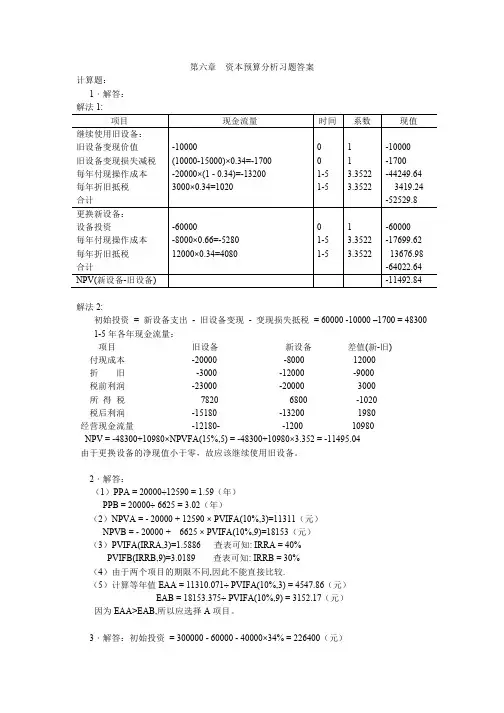
第六章资本预算分析习题答案计算题:1.解答:解法1:项目现金流量时间系数现值继续使用旧设备:旧设备变现价值-10000 0 1 -10000旧设备变现损失减税(10000-15000)×0.34=-1700 0 1 -1700每年付现操作成本-20000×(1 - 0.34)=-13200 1-5 3.3522 -44249.64 每年折旧抵税3000×0.34=1020 1-5 3.3522 3419.24 合计-52529.8 更换新设备:设备投资-60000 0 1 -60000每年付现操作成本-8000×0.66=-5280 1-5 3.3522 -17699.62 每年折旧抵税12000×0.34=4080 1-5 3.3522 13676.98 合计-64022.64 NPV(新设备-旧设备) -11492.84解法2:初始投资= 新设备支出- 旧设备变现- 变现损失抵税= 60000 -10000 –1700 = 48300 1-5年各年现金流量:项目旧设备新设备差值(新-旧)付现成本-20000 -8000 12000折旧-3000 -12000 -9000税前利润-23000 -20000 3000所得税7820 6800 -1020税后利润-15180 -13200 1980经营现金流量-12180- -1200 10980NPV = -48300+10980×NPVFA(15%,5) = -48300+10980×3.352 = -11495.04由于更换设备的净现值小于零,故应该继续使用旧设备。
2.解答:(1)PPA = 20000÷12590 = 1.59(年)PPB = 20000÷ 6625 = 3.02(年)(2)NPVA = - 20000 + 12590 × PVIFA(10%,3)=11311(元)NPVB = - 20000 + 6625 × PVIFA(10%,9)=18153(元)(3)PVIFA(IRRA,3)=1.5886 查表可知: IRRA = 40%PVIFB(IRRB,9)=3.0189 查表可知: IRRB = 30%(4)由于两个项目的期限不同,因此不能直接比较.(5)计算等年值EAA = 11310.071÷ PVIFA(10%,3) = 4547.86(元)EAB = 18153.375÷ PVIFA(10%,9) = 3152.17(元)因为EAA>EAB,所以应选择A项目。
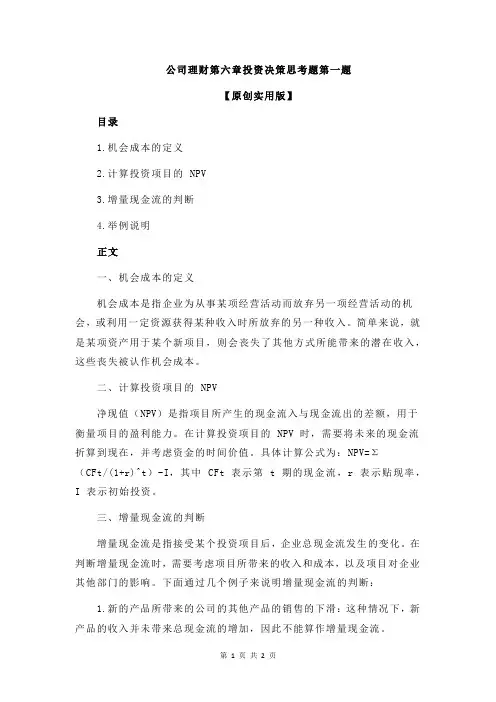
公司理财第六章投资决策思考题第一题【原创实用版】目录1.机会成本的定义2.计算投资项目的 NPV3.增量现金流的判断4.举例说明正文一、机会成本的定义机会成本是指企业为从事某项经营活动而放弃另一项经营活动的机会,或利用一定资源获得某种收入时所放弃的另一种收入。
简单来说,就是某项资产用于某个新项目,则会丧失了其他方式所能带来的潜在收入,这些丧失被认作机会成本。
二、计算投资项目的 NPV净现值(NPV)是指项目所产生的现金流入与现金流出的差额,用于衡量项目的盈利能力。
在计算投资项目的 NPV 时,需要将未来的现金流折算到现在,并考虑资金的时间价值。
具体计算公式为:NPV=Σ(CFt/(1+r)^t)-I,其中 CFt 表示第 t 期的现金流,r 表示贴现率,I 表示初始投资。
三、增量现金流的判断增量现金流是指接受某个投资项目后,企业总现金流发生的变化。
在判断增量现金流时,需要考虑项目所带来的收入和成本,以及项目对企业其他部门的影响。
下面通过几个例子来说明增量现金流的判断:1.新的产品所带来的公司的其他产品的销售的下滑:这种情况下,新产品的收入并未带来总现金流的增加,因此不能算作增量现金流。
2.只有新的项目被接受,才会开始投入建造的机器和厂房:在这种情况下,新项目的投资带来了机器和厂房的建设,从而产生了新的收入,这部分收入可以算作增量现金流。
3.过去的 3 年发生的和新项目相关的研发费用:这部分费用已经在过去发生,无论接受与否,都不会对现在的总现金流产生影响,因此不能算作增量现金流。
4.新项目每年的折旧费用:新项目的折旧费用是对投资成本的收回,不会对总现金流产生影响,因此不能算作增量现金流。
5.公司发放的股利:股利是企业利润的分配,不是投资项目的现金流,因此不能算作增量现金流。
6.新项目结束时,销售厂房和机器设备:新项目结束后,销售厂房和机器设备所得到的收入,属于投资项目的现金流,可以算作增量现金流。
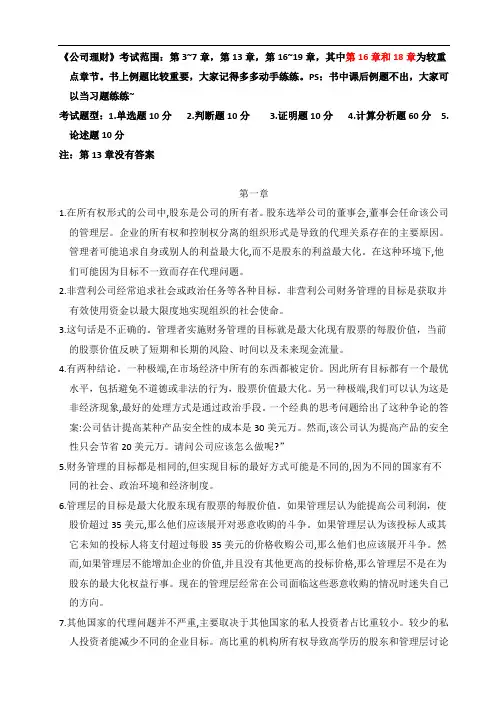
《公司理财》考试范围:第3~7章,第13章,第16~19章,其中第16章和18章为较重点章节。
书上例题比较重要,大家记得多多动手练练。
PS:书中课后例题不出,大家可以当习题练练~考试题型:1.单选题10分 2.判断题10分 3.证明题10分 4.计算分析题60分 5.论述题10分注:第13章没有答案第一章1.在所有权形式的公司中,股东是公司的所有者。
股东选举公司的董事会,董事会任命该公司的管理层。
企业的所有权和控制权分离的组织形式是导致的代理关系存在的主要原因。
管理者可能追求自身或别人的利益最大化,而不是股东的利益最大化。
在这种环境下,他们可能因为目标不一致而存在代理问题。
2.非营利公司经常追求社会或政治任务等各种目标。
非营利公司财务管理的目标是获取并有效使用资金以最大限度地实现组织的社会使命。
3.这句话是不正确的。
管理者实施财务管理的目标就是最大化现有股票的每股价值,当前的股票价值反映了短期和长期的风险、时间以及未来现金流量。
4.有两种结论。
一种极端,在市场经济中所有的东西都被定价。
因此所有目标都有一个最优水平,包括避免不道德或非法的行为,股票价值最大化。
另一种极端,我们可以认为这是非经济现象,最好的处理方式是通过政治手段。
一个经典的思考问题给出了这种争论的答案:公司估计提高某种产品安全性的成本是30美元万。
然而,该公司认为提高产品的安全性只会节省20美元万。
请问公司应该怎么做呢?”5.财务管理的目标都是相同的,但实现目标的最好方式可能是不同的,因为不同的国家有不同的社会、政治环境和经济制度。
6.管理层的目标是最大化股东现有股票的每股价值。
如果管理层认为能提高公司利润,使股价超过35美元,那么他们应该展开对恶意收购的斗争。
如果管理层认为该投标人或其它未知的投标人将支付超过每股35美元的价格收购公司,那么他们也应该展开斗争。
然而,如果管理层不能增加企业的价值,并且没有其他更高的投标价格,那么管理层不是在为股东的最大化权益行事。
{财务管理公司理财}公司理财第六章笔记整理第六章投资决策6.1、本章要点公司在生产经营中经常面临资本预算决策,上一章介绍了资本预算的几种方法,本章将进一步探讨此类决策。
本章的主要内容有两方面:由于对现金流的估计值是净现值分析中很重要的一环,因此本章要探讨现金流来源于何处以及如何计算现金流等问题。
其次,需要理解在不同的情形中,如何对资本预算得到的净现值进行评估,比如项目周期不同时,就不能直接比较两种项目的净现值。
本章各部分要点如下:1.增量现金流量净现值是现金流量而不是利润的折现。
当考虑一个项目时,对项目产生的现金流量进行折现。
当从整体评价一家公司时,对股利而不是利润进行折现,因为股利是投资者收到的现金流量。
在计算项目的净现值时,所运用的现金流量应该是因项目而产生的现金流量“增量”。
从增量现金流的角度出发,必须注意沉没成本、机会成本、副效应、成本分摊等问题。
2.鲍尔温公司案例3.为了清楚地说明计算现金流量的方法,本章引入了一个综合案例——鲍尔温公司案例,帮助同学们了解现金流计算的基本方法和其中的重点。
在案例中,需要关注项目现金流的构成,以及各自的计算方法。
3.通货膨胀与资本预算在存在通货膨胀的情况下,名义利率和实际利率不同,名义现金流也需要调整通货膨胀后才能得到实际现金流。
计算项目价值时,应该在现金流量和折现率之间保持一致性:名义现金流量应以名义利率折现;实际现金流量应以实际利率折现。
在实际运算中选择最简单的方法计算。
4.经营性现金流量的不同算法5.本部分介绍了三种计算经营现金流的方法:自上而下法、自下而上法、税盾法。
每一种方法得到的现金流都是一致的,在实际操作中,哪种方法最容易使用,就可以采用哪种方法。
6.5.不同生命周期的投资7.假设公司必须在两种不同生命周期的项目中做出选择,此时简单地运用NPV法则会造成错误的结果。
如果项目的收入完全相同,此时可以采用约当年均成本法。
6.2重难点导学一、增量现金流量:资本预算的关键1.现金流量而非“会计利润”公司理财课程和财务会计课程有很大的区别。
第一章公司理财导论1.代理问题谁拥有公司?描述所有者控制公司管理层的过程。
代理关系在公司的组织形式中存在的主要原因是什么?在这种环境下,可能会出现什么样的问题?解:股东拥有公司;股东选举董事会,董事会选举管理层(股东→董事会→管理层);代理关系在公司的组织形式中存在的主要原因是所有权和控制权的分离;在这种情况下,可能会产生代理问题(股东和管理层可能因为目标不一致而使管理层可能追求自身或别人的利益最大化,而不是股东的利益最大化)。
2.非营利企业的目标假设你是一家非营利企业(或许是非营利医院)的财务经理,你认为什么样的财务管理目标将会是恰当的?解:所有者权益的市场价值的最大化。
3.公司的目标评价下面这句话:管理者不应该只关注现在的股票价值,因为这么做将会导致过分强调短期利润而牺牲长期利润。
解:错误;因为现在的股票价值已经反应了短期和长期的的风险、时间以及未来现金流量。
4.道德规范和公司目标股票价值最大化的目标可能和其他目标,比如避免不道德或者非法的行为相冲突吗?特别是,你认为顾客和员工的安全、环境和社会的总体利益是否在这个框架之内,或者他们完全被忽略了?考虑一些具体的情形来阐明你的回答。
解:有两种极端。
一种极端,所有的东西都被定价。
因此所有目标都有一个最优水平,包括避免不道德或非法的行为,股票价值最大化。
另一种极端,我们可以认为这是非经济现象,最好的处理方式是通过政治手段。
一个经典的思考问题给出了这种争论的答案:公司估计提高某种产品安全性的成本是30万美元。
然而,该公司认为提高产品的安全性只会节省20万美元。
请问公司应该怎么做呢?”5.跨国公司目标股票价值最大化的财务管理目标在外国会有不同吗?为什么?解:财务管理的目标都是相同的,但实现目标的最好方式可能是不同的(因为不同的国家有不同的社会、政治环境和经济制度)。
6.代理问题假设你拥有一家公司的股票,每股股票现在的价格是25美元。
另外一家公司刚刚宣布它想要购买这个公司,愿意以每股35美元的价格收购发行在外的所有股票。
第一章公司理财专项1.公司理财的发展阶段,答案见教材P3。
2.公司理财的目标,答案见教材P5。
第二章公司理财环境分析1. 公司理财理论结构,答案见教材P23。
2. 公司理财环境,答案见教材P25。
3. 金融市场的分类,答案见教材P28。
4. 金融中介机构,答案见教材P32。
第三章财务报表阅读与分析1.阅读资产负债表应注意的问题,答案见教材P41、43。
2.答案见教材P83。
3.资产负债表等式:资产=负债+所有者权益利润表等式:利润=收入—费用4.分析企业的销售净利率指标,并对比分析。
5.计算销售毛利率和销售净利率指标。
第四章时间价值1.时间价值,答案见教材P96。
2.复利,答案见教材P98。
3.现值与终值,答案见教材P98。
4.年金,答案见教材P100。
5.普通年金,又称后付年金,普通年金的终值和现值的计算见教材P100。
6.答案:5000×3.9927×0.6806=13587(元)7.答案:PV A8 =A·PVIFA9%,8=10000×5.5348=55348>50000应选择甲设备8. 答案见教材P102。
9. 答案:(1)1800×(P/A,10,6%)=1800×7.3601=13 248.18(元)(2)1800×(F/A,10,6%)=1800×13.181=23 725.8(元)第五章风险分析1.答案见教材P113。
2.答案见教材P115。
3.答案见教材P118。
4. 资产组合的收益率=10%×30%+13%×40%+16%×30%=0.13第六章资本成本分析1.答案见教材P130。
2.答案见教材P134。
3.WACC=9%×(1-25%)×35%+15%×65%=12%4.该借款的资本成本=300×6%×(1-25%)/[300×(1-0.15%)]6.答案见教材P133页例6-5。
公司理财学原理第六章习题答案二、单项选择题1.资金占用成本是指企业因占用资金而向资金供应者支付的各种资金占用费,以下不属于资金占用成本的是(C )。
A.长期债券的利息B.各种长短期借款的利息C.发行股票的承销费用D.优先股的股息2.某公司向银行借款500万元,年利率为5%、期限为2年,到期一次还本付息,发生资产评估、信用评估等手续费为15万元,不考虑其他因素,该长期借款的资金成本是(B )。
A.5%B.6.49%C.4.04%D.4.88%【正确答案】B,当i=((500+500*5%*2)/(500-15))^0.5-1=6.49%3.某公司发行面值为1000万元、票面利率为6%、期限为2年的债券,每年年末付息,到期还本,发行价格为1030万元,发行手续费为20万元,不考虑其他因素,用插值法计算,该债券资金成本是( D )。
A.6%B.4.54%C.7.11%D.5.54%【正确答案】D,当i=5%,NPV=1018.59,当i=6%,NPV=10004.某公司发行面值为100万元、票面利率为8%的优先股票,每年年末付息,发行价格为108万元,承销费用等手续费为5万元,不考虑其他因素,该债券资金成本是( D )。
A.7.77%B.7.41%C.8%D.无法计算【正确答案】D,i=100*8%/(108-5)=7.77%5.某公司发行的长期债券面值为1 000元/ 张,共10 000张,年利息率为10%,每年年末付息,到期还本,期限为10年。
债券按面值溢价12%发行,筹资费用为债券面值的12%。
公司的所得税率为25%,该债券的税后资金成本为( C )。
A.10%B.12%C.7.5%D.9%6.某公司发行优先股,面值为1 000元/股,票面利率为12%,溢价发行,发行价为1 300元/股,另按发行价的2%支付承销费,公司所得税率为25%,从企业角度看,该优先股票的资金成本为(D )。
A.9.42%B .9.23%C .12.18%D .9.37%【正确答案】D 解: 根据公式得:%37.9%)251(%213001300%121000=-⨯⨯-⨯=资金成本优先股票7.某公开发行A 股的股份有限公司采取固定股利政策,每年股利为0.84元/股,当前股价为7.5元/股,公司所得税税率为25%,该公司普通股票的资金成本为( B )。
公司理财第六章投资决策思考题第一题
【实用版】
目录
1.机会成本的定义
2.计算投资项目的 NPV
3.增量现金流的判断
4.举例说明
正文
一、机会成本的定义
机会成本是指企业为从事某项经营活动而放弃另一项经营活动的机会,或利用一定资源获得某种收入时所放弃的另一种收入。
简单来说,就是选择一种方案所丧失的其他选择方案的潜在收益。
在投资决策中,机会成本是评估项目价值的重要因素,可以帮助企业更好地选择投资项目。
二、计算投资项目的 NPV
净现值(NPV)是指项目所产生的现金流入与现金流出的差额,用于评估项目的盈利能力。
计算公式为:NPV=Σ(CFt/(1+r)^t)-I,其中 CFt 表示第 t 期的现金流量,r 表示贴现率,I 表示初始投资额。
当 NPV>0 时,说明项目的盈利能力超过预期收益,可以考虑投资;当 NPV<0 时,说明项目的盈利能力不足以达到预期收益,应放弃投资。
三、增量现金流的判断
增量现金流是指接受某个投资项目后,企业现金流入的增量。
在计算增量现金流时,需要考虑项目所带来的收入、成本和折旧等因素。
在判断增量现金流时,需要注意以下几点:
1.只考虑项目直接带来的现金流变化,不考虑间接影响;
2.只考虑未来预期的现金流变化,不考虑过去已经发生的现金流;
3.只考虑项目由于接受而产生的现金流变化,不考虑项目拒绝而产生的现金流变化。
四、举例说明
假设某公司面临两个投资项目 A 和 B,项目 A 的初始投资额为100 万元,预期年现金流入为 20 万元,项目 B 的初始投资额为 150 万元,预期年现金流入为 30 万元。
公司的贴现率为 10%。
1.计算项目 A 的 NPV:
NPV(A)=20/(1+10%)^1+20/(1+10%)^2+20/(1+10%)^3-100=43.59 万元。
2.计算项目 B 的 NPV:
NPV(B)=30/(1+10%)^1+30/(1+10%)^2+30/(1+10%)^3-150=25.63 万元。